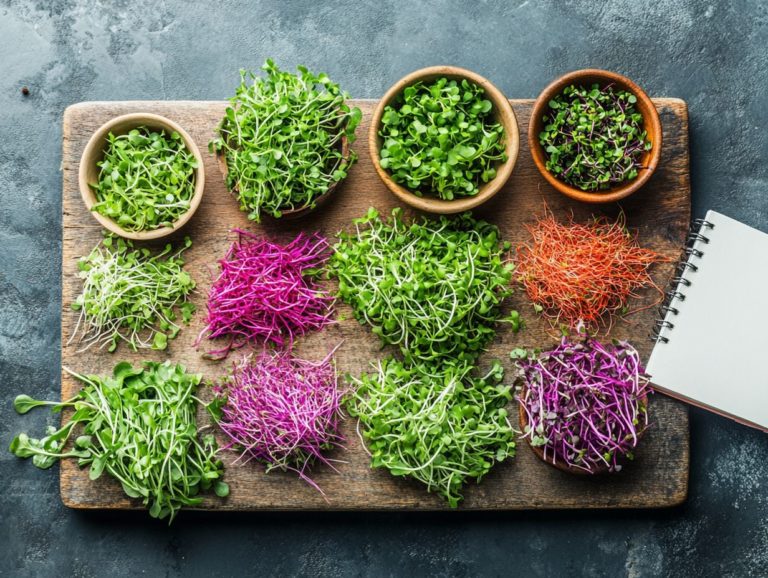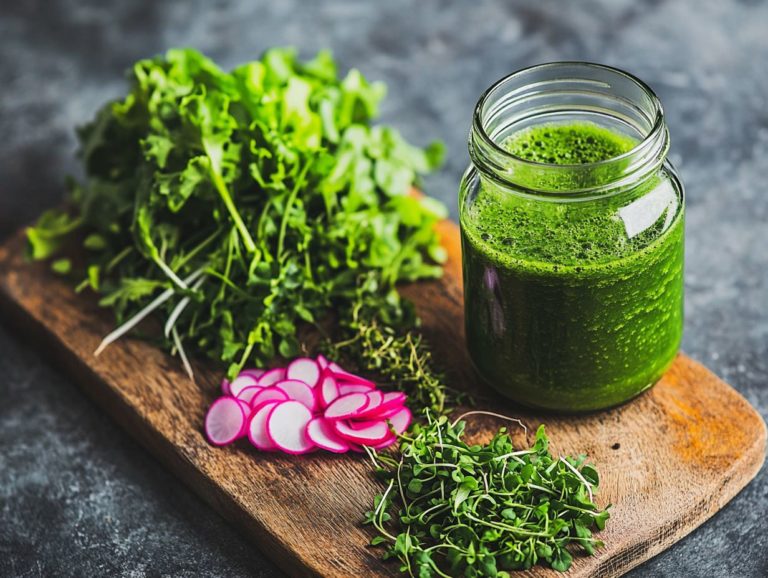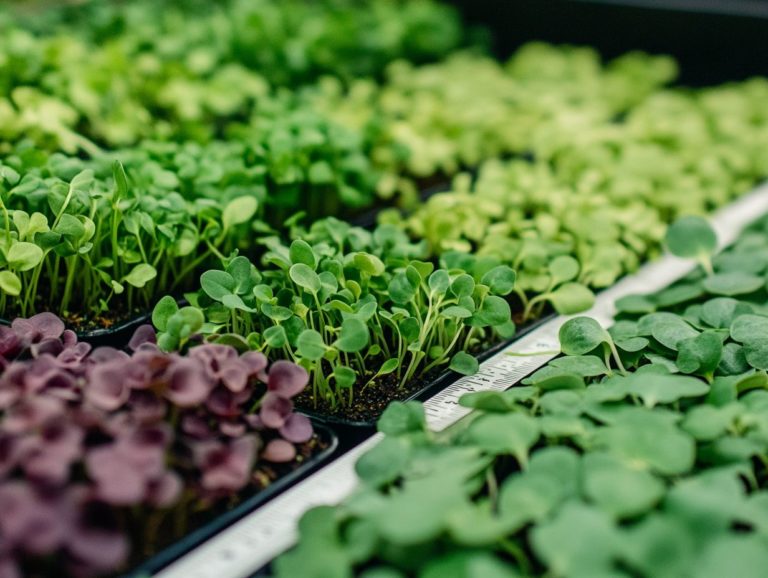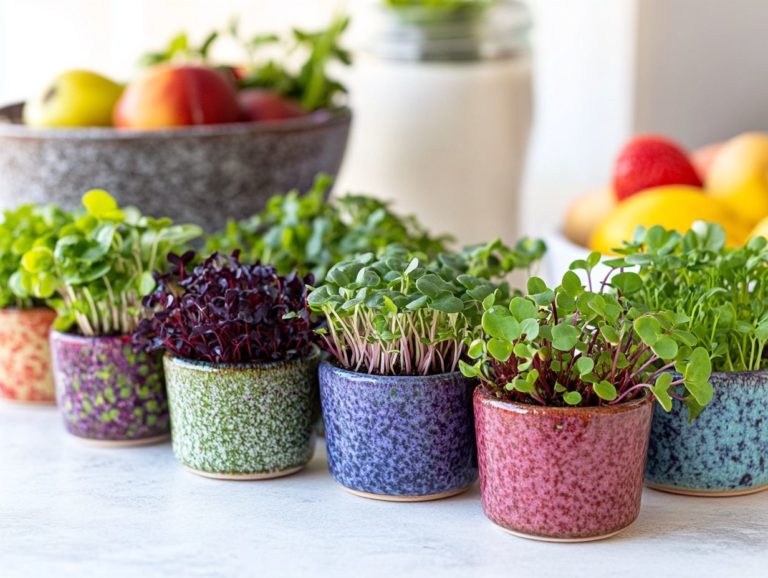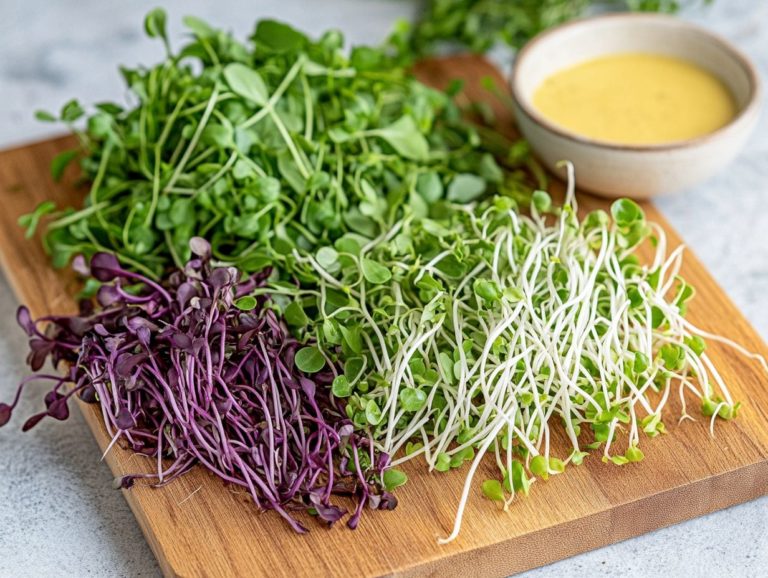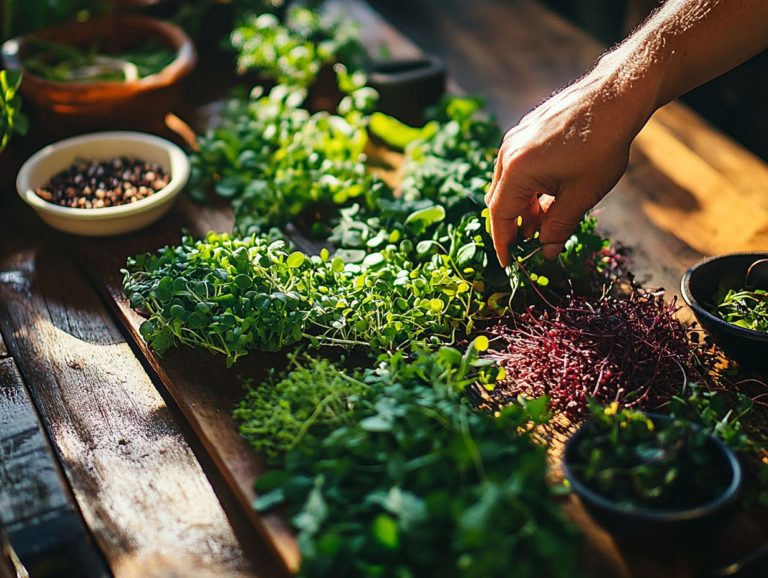Microgreen Varieties: What You Need to Know
Discover the vibrant world of microgreens and transform your meals today! Microgreens are not just tiny plants; they are packed with nutrients that can elevate both your culinary creations and your overall well-being.
This article delves into popular varieties of microgreens, each boasting its own distinctive flavors and characteristics. You ll find a step-by-step guide to growing these greens right in your own home, making it simple to enjoy their benefits.
We also spotlight the remarkable nutritional value they provide and offer innovative ideas for incorporating microgreens into your meals. Get ready to enhance your culinary experience!
Contents
Key Takeaways:
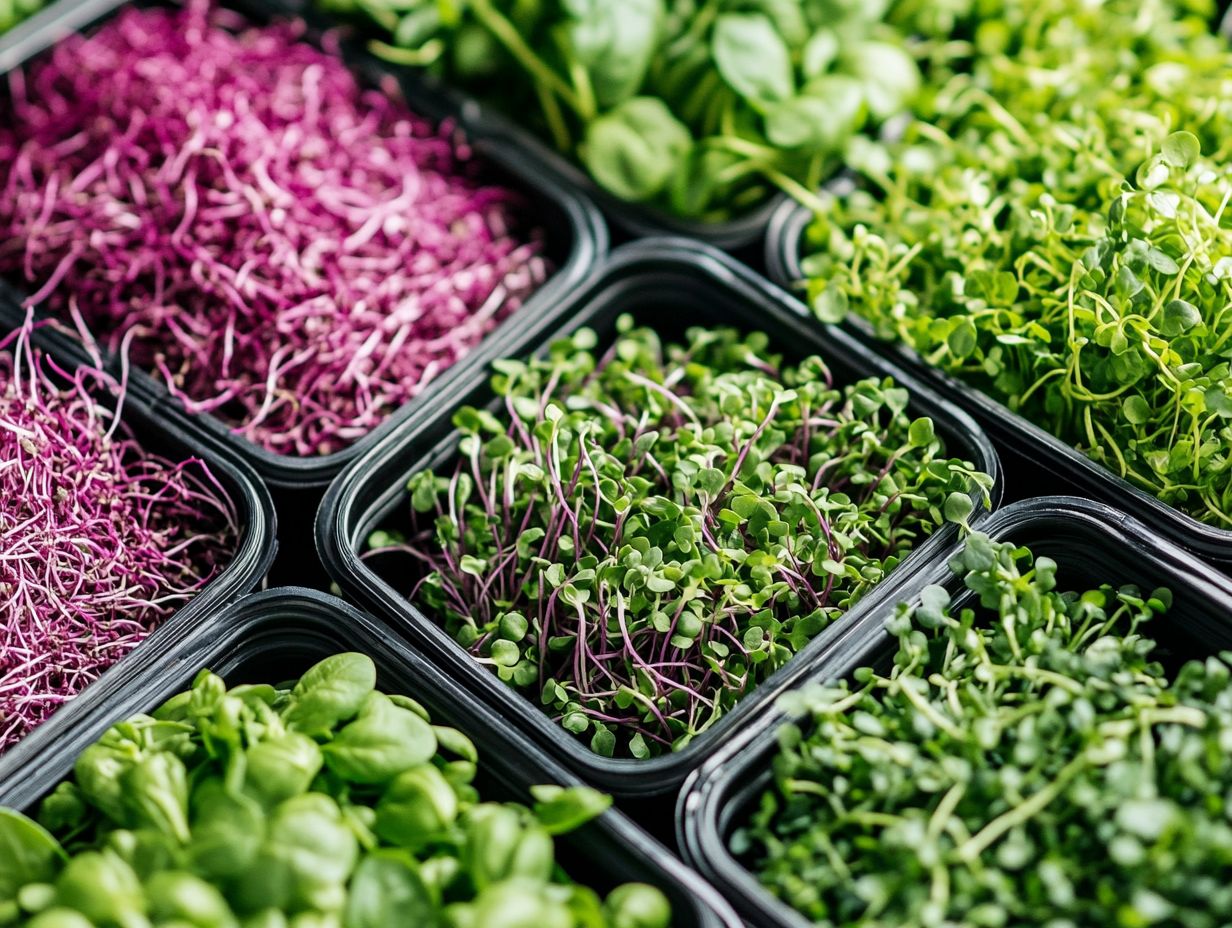
- Explore a wide variety of microgreens like broccoli, radish, and sunflower to add flavor, color, and nutrients to your meals!
- Grow microgreens at home easily with a simple step-by-step guide and enjoy fresh, organic produce!
- Incorporate microgreens into your diet for a nutritious boost by adding them to salads, sandwiches, smoothies, or trying creative recipes like microgreen pesto and omelets!
What are Microgreens?
Microgreens are young, edible plants harvested just after the first true leaves develop. They come in an impressive array of flavors and colors, making them a favorite among health-conscious individuals seeking to maximize their nutritional benefits.
Often hailed as superfoods, varieties like broccoli, arugula, and kale are rich in vitamins, minerals, and antioxidants that can significantly elevate your diet. Grown from microgreen seeds, these little powerhouses thrive indoors using methods like growing plants without soil or traditional soil methods. For those interested in maximizing their yields, exploring the most profitable microgreen varieties to grow offers a versatile option for indoor gardening enthusiasts.
These vibrant plants not only add a splash of color to your dishes but also bring unique flavor profiles that range from zesty to mild, enhancing everything from salads to gourmet entrees.
If you re new to gardening, you can easily dive into this trend by using specially designed microgreen kits that simplify the planting process. With minimal space and resources required, growing microgreens can be a fulfilling journey that encourages healthy eating habits while allowing you to take pride in nurturing your own fresh ingredients.
Plus, the quick turnaround from seed to harvest makes this a particularly enticing option for anyone looking for instant gratification in their gardening adventures.
Popular Varieties of Microgreens
Popular varieties of microgreens present a delightful range of flavors, textures, and nutritional benefits, establishing them as essentials in both home kitchens and upscale restaurants. Each type of microgreen, whether it s the spicy kick of radish or the earthy essence of kale, offers unique flavor profiles and health advantages.
Varieties like alfalfa, broccoli, and sunflower microgreens are particularly favored for their ease of growth and remarkable nutrient content. Herbs like basil and cilantro can also be grown as microgreens, enhancing the versatility of your indoor gardening endeavors.
Common Types and Their Characteristics
Common types of microgreens, such as broccoli, arugula, and radish, each have unique characteristics that cater to your culinary preferences and health needs.
These microgreens elevate the visual appeal of your dishes while introducing a delightful complexity of flavors. For instance, broccoli microgreens are rich in vitamins A, C, and K, promoting overall health while their subtle earthiness enhances the freshness of your salads. To explore more about the best options, check out the top microgreen varieties for gourmet cooking.
Arugula microgreens infuse your meals with a peppery bite, making them perfect for pairing with creamy cheeses or grilled meats. Radish microgreens, bursting with antioxidants, add a kick of heat and a satisfying crunch, which contrasts beautifully in stir-fries.
By incorporating these nutrient-dense microgreens into your everyday recipes, you ensure a colorful presentation while supporting a balanced diet showcasing the perfect harmony of health and flavor!
Growing Microgreens at Home

Growing microgreens at home is a truly rewarding and accessible hobby. Anyone from seasoned gardeners to enthusiastic beginners can reap the benefits of indoor gardening.
Thanks to the increasing popularity of microgreen kits, cultivating a diverse array of microgreens has never been simpler. You can choose to grow them in soil or use the hydroponic method, which involves growing plants in water without soil. For health enthusiasts, exploring the top microgreen varieties can enhance your gardening experience.
Start your journey by soaking microgreen seeds to enhance germination. This step paves the way for a successful growing experience. To elevate your salads, consider experimenting with must-try microgreen varieties. These vibrant greens sprout quickly and take up little space, making them perfect for city dwellers or those with limited gardening backgrounds.
Step-by-Step Guide to Growing Microgreens
To successfully grow microgreens, choose your preferred seeds and prepare them through a straightforward seed soaking process to enhance germination. After soaking, sow the seeds in a container filled with soil or opt for hydroponic techniques. Microgreen kits often include all the supplies you need, making this an accessible choice for budding gardening enthusiasts.
Once you’ve chosen your containers whether traditional pots or hydroponic trays fill them with a high-quality growing medium if using soil. For hydroponics, ensure your nutrient solution is well-mixed to support robust growth.
Evenly spread the soaked seeds across the surface, providing ample space for each seed to flourish without overcrowding. Lightly cover the seeds with a thin layer of soil or a growing mat, and mist the surface to maintain moisture.
Consistency is key when it comes to watering. Keep the soil damp but not waterlogged, or monitor the moisture levels in your hydroponic system.
When your microgreens reach a height of 1-3 inches, don’t wait! Harvest them just above the soil line to enjoy the freshest taste.
Why You Should Eat Microgreens Now!
The advantages of incorporating microgreens into your diet extend beyond their delightful flavors and eye-catching presentation. These greens are celebrated for their remarkable nutritional profile, making them an invaluable asset to any healthy eating regimen.
As superfoods, microgreens deliver concentrated levels of vitamins, minerals, and antioxidants, often outshining the nutritional benefits of their fully grown counterparts. By adding a variety of microgreens to your meals, you can significantly support your overall health, strengthen your immunity, and improve digestion.
Microgreens boast higher concentrations of vitamins and minerals than their mature vegetable counterparts. For instance, broccoli microgreens are packed with vitamins C and K, while sunflower microgreens offer a treasure trove of healthy fats and protein. Additionally, exploring the benefits of growing diverse microgreen varieties can enhance your culinary experience and nutritional intake.
These petite greens embody the essence of superfoods, supporting your healthy eating habits and offering numerous health benefits, from improved digestion to enhanced immune function.
Rich in phytonutrients and antioxidants, microgreens can outperform larger vegetables in nutritional content. Research shows that radish microgreens are particularly impressive, containing high levels of vitamins A and E along with antioxidants that help combat inflammation and promote heart health. For those interested in growing them, exploring seasonal microgreen varieties for year-round growth can be beneficial.
When compared to traditional veggies like spinach or kale, these nutrient-dense greens provide a concentrated dose of essential minerals such as magnesium and potassium. They not only contribute to your overall well-being but also elevate your culinary creations, inspiring you to embrace healthier food choices.
How to Incorporate Microgreens into Your Diet
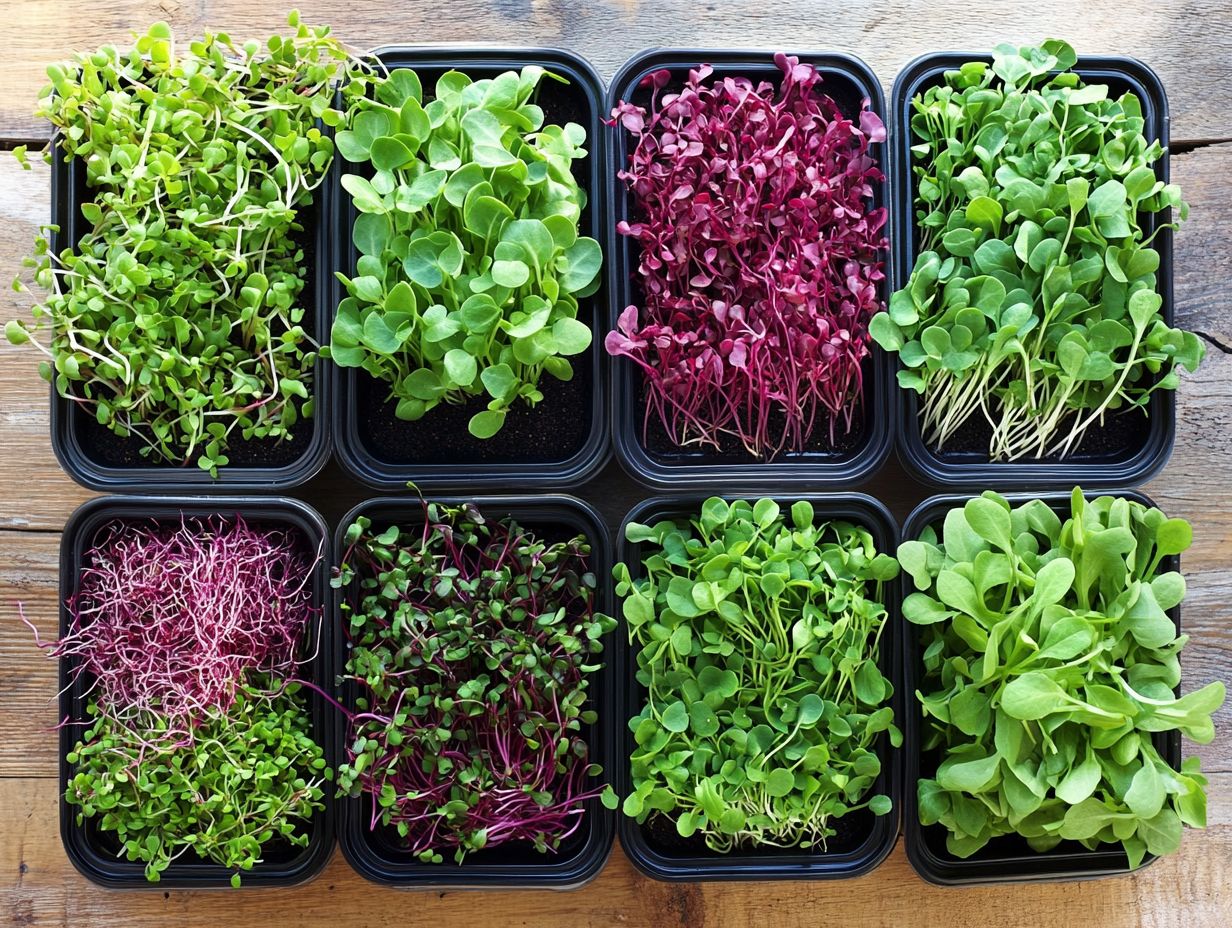
Incorporating microgreens into your diet elevates the flavor and nutrition of your meals. This opens up a world of culinary possibilities.
These petite, nutrient-packed shoots enhance salads, sandwiches, and smoothies, infusing them with a refreshing burst of taste.
With their varied flavor profiles, ranging from mild to peppery, microgreens align seamlessly with your commitment to healthy eating.
Recipe Ideas and Tips for Adding Microgreens to Meals
You have a world of recipe possibilities at your fingertips, ready to elevate your meals with these nutritious little shoots. Imagine topping your favorite omelet with spicy radish microgreens or tossing a handful of arugula microgreens into a fresh salad.
Blend sunflower microgreens into your smoothie for a delightful nutrient boost. With a dash of creativity, you’ll amaze your guests when you transform ordinary dishes into gourmet experiences.
Experimenting with different varieties elevates flavors and enhances the visual appeal of your dishes. Picture using pea shoots to whip up a vibrant pesto, perfect for spreading on crusty bread or drizzling over grilled vegetables.
As a garnish, microgreens add delightful crunch and bursts of flavor to soups and main dishes.
Don t shy away from mixing colors and textures. Combining bright purple basil microgreens with mustard greens creates a visually striking topping for your tacos. The beauty of cooking with microgreens lies in their versatility, inviting you to indulge your creativity and make every meal a celebration.
Frequently Asked Questions
What are microgreens and why are they gaining popularity?
Microgreens are small, edible plants harvested when they are just a few inches tall. They are popular because they are packed with nutrients and have a concentrated flavor, making them a versatile and healthy addition to any meal.
What are the most common varieties of microgreens?
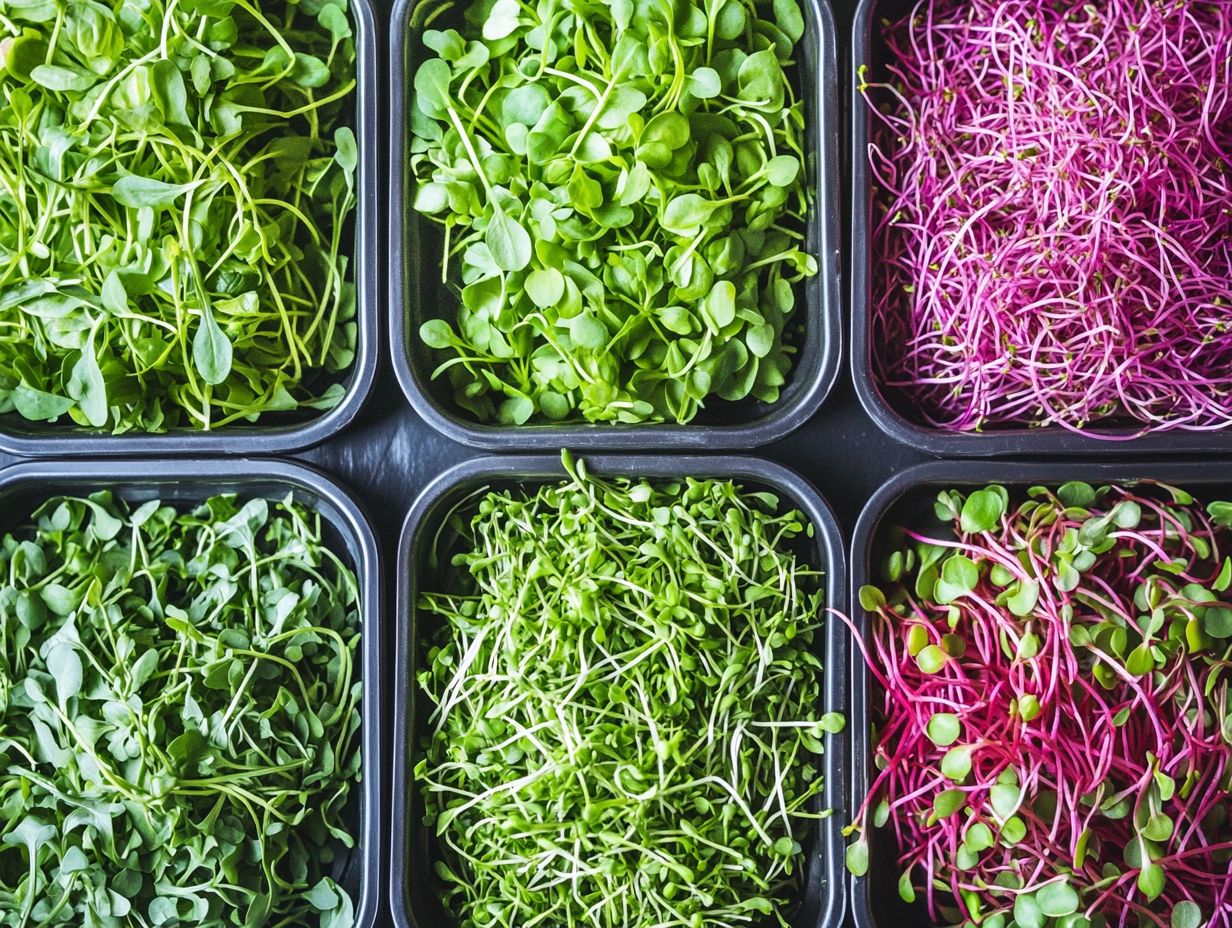
Common microgreen varieties include broccoli, kale, radish, pea shoots, and sunflower shoots. Other varieties to explore are amaranth, cilantro, and mustard greens. Some, like alfalfa and arugula, are particularly easy to grow for beginner gardeners.
How do I grow microgreens?
You can grow microgreens indoors or outdoors, in soil or without soil using special systems. They need little space and grow quickly, usually ready to harvest in 1-3 weeks. Growing microgreens from microgreen seeds is a popular method for home growers.
What are the differences between microgreens and sprouts?
Microgreens and sprouts are often confused, but they are not the same. Sprouts are germinated seeds typically grown in water and eaten whole. In contrast, microgreens are grown in soil and harvested when they develop their first set of true leaves.
Are all microgreens safe to eat?
Most microgreens are safe to eat and are a healthy addition to any diet. However, it s important to research the specific variety you are consuming. Some microgreens may have toxic compounds or can be contaminated if not grown properly. For instance, growing plants in water without soil can sometimes lead to issues if not managed correctly.
In what ways can I incorporate microgreens into my meals?
You can add microgreens to salads, sandwiches, smoothies, soups, and more. They also serve as a garnish or topping for various dishes, adding a burst of color and flavor. Get creative and enjoy the delicious flavors microgreens can bring to your meals!

